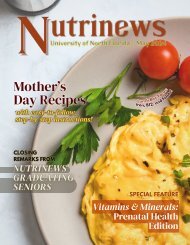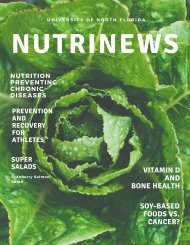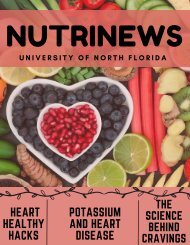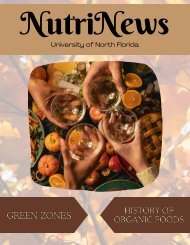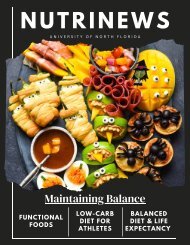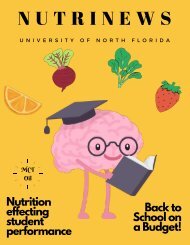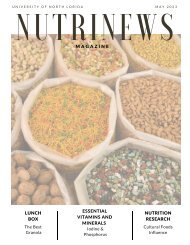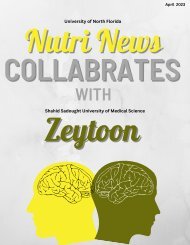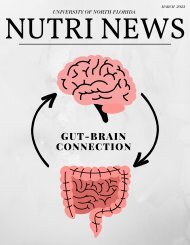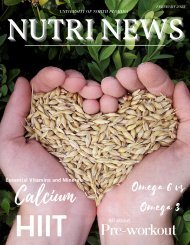Nutri News January 2023
Happy New Year!!!! This month theme is Nutrition Resolutions!! You will find articles about: • Why should you ditch the new year diet resolution this 2023. Say No to Yoyo dieting! • The pros and cons of Nutraceutical. Are they safe? • Do you want to eat more vegetables but don’t know how? Go to page 11 and check out this delicious kale chips recipe! • The relationship between a plant base diet and colorectal cancer. New findings in the world of nutrition. • To take or not to take the gummy vitamins, check out the myth busting article to find the answer • Injuries are common and often unavoidable for those who participate in sport related activities. How can your current diet affect the healing process • Have you heard about Thiamin & Riboflavin? You might want to check out our essential guide to vitamins and minerals article to learn more about their role on your health!! If you are looking to make an impact on campus as well as in the community, look for the fliers highlighting volunteer opportunities. These amazing programs are always looking for more volunteers. It is amazing the difference we can make when we all work together for a better and healthier tomorrow. Happy reading! Saily Medero Editor-In-Chief UNF NutriNews
Happy New Year!!!!
This month theme is Nutrition Resolutions!!
You will find articles about:
• Why should you ditch the new year diet resolution this 2023. Say No to Yoyo dieting!
• The pros and cons of Nutraceutical. Are they safe?
• Do you want to eat more vegetables but don’t know how? Go to page 11 and check out this delicious kale chips recipe!
• The relationship between a plant base diet and colorectal cancer. New findings in the world of nutrition.
• To take or not to take the gummy vitamins, check out the myth busting article to find the answer
• Injuries are common and often unavoidable for those who participate in sport related activities. How can your current diet affect the healing process
• Have you heard about Thiamin & Riboflavin? You might want to check out our essential guide to vitamins and minerals article to learn more about their role on your health!!
If you are looking to make an impact on campus as well as in the community, look for the fliers highlighting volunteer opportunities. These amazing programs are always looking for more volunteers. It is amazing the difference we can make when we all work together for a better and healthier tomorrow.
Happy reading!
Saily Medero
Editor-In-Chief
UNF NutriNews
You also want an ePaper? Increase the reach of your titles
YUMPU automatically turns print PDFs into web optimized ePapers that Google loves.
UNIVERSITY OF NORTH FLORIDA<br />
JANUARY 2O23<br />
NUTRI NEWS<br />
H A P P Y<br />
New Year<br />
research<br />
roundup<br />
Plant based diet and colorectal cancer<br />
Vitamins<br />
thiamin + riboflavin<br />
T H E L U N C H<br />
B O X<br />
Kale Chips
TABLE OF<br />
CONTENT<br />
04.<br />
08.<br />
YOUR ESSENTIAL GUIDE TO VITAMINS<br />
AND MINERALS<br />
Thiamin & Riboflavin<br />
MYTHBUSTING<br />
How effective are gummy vitamins<br />
11.<br />
THE LUNCH BOX<br />
Kale Chips<br />
13.<br />
17.<br />
RESEARCH ROUND UP<br />
Plant based diet and colorectal<br />
cancer<br />
NUTRITION SCIENCE<br />
What are nutraceuticals?<br />
20.<br />
NUTRITION RESEARCH<br />
Should I ditch the New Year diet?<br />
EAT<br />
WELL<br />
LIVE<br />
WELL<br />
23.<br />
26.<br />
SPORTS NUTRITION<br />
The influence of diet in sports injuries<br />
NUTRINEWS STAFF<br />
Follow us!<br />
@unfnutrinews
Your Essential Guide to<br />
Vitamins and Minerals<br />
Thiamin and Riboflavin<br />
Written by:<br />
Ashley Valle<br />
B vitamins are vital to our body's<br />
processes, they help us get energy from<br />
the food we consume, make new red<br />
blood cells1, and maintain the health of<br />
the body's tissues2. In this month’s issue,<br />
we will focus on two B vitamins, thiamin<br />
and riboflavin, also known as vitamins B1<br />
& B2.<br />
Thiamin (B1) is a water-soluble vitamin<br />
(like the other B vitamins) vital to the<br />
health of cells in the human body.³ It is<br />
stored in the heart, liver, kidneys, and<br />
brain – but only for a short period of<br />
time⁴, and excess is excreted through the<br />
urine. Because thiamin is only kept in our<br />
bodies for short periods of time, it is<br />
important to maintain a consistent and<br />
adequate consumption of this vitamin to<br />
avoid deficiency.⁴ Thiamine is found in<br />
various foods and is readily available<br />
throughout food groups, examples of<br />
sources of this vitamin are mung beans,<br />
enriched grain products, nuts, pork,<br />
poultry, fruits, and whole grains.⁴<br />
Thiamin deficiency, although<br />
uncommon, is possible and can be<br />
detrimental if left untreated. Edema,<br />
moon face, inability to concentrate,<br />
defective memory, weight loss, cardiac<br />
symptoms and disorientation are<br />
possible physical manifestations of<br />
thiamin deficiency.⁴⁵ One condition that<br />
may happen because of thiamin<br />
deficiency is Beriberi, there are two types<br />
with varying symptoms6. Wet beriberi is<br />
characterized by edema, heightened<br />
heart rate, and shortness of breath. Dry is<br />
characterized by confusion, pain,<br />
numbness in extremities, and more6.<br />
4
Riboflavin (B2) is found in beef liver, eggs,<br />
fortified breakfast cereals & oats, yogurt,<br />
mushrooms, spinach, apples, and more⁷.<br />
This water-soluble vitamin is found in<br />
high amounts in animal foods, for<br />
countries where animal foods are a<br />
luxury, riboflavin deficiency is more<br />
common⁷. Riboflavin deficiency can<br />
result in symptoms such as edema of the<br />
mouth and throat, sore throat, cheilosis,<br />
glossitis, angular stomatitis, hair loss, and<br />
more, people who consume small<br />
amounts of milk and meat products,<br />
lactating and pregnant women, and<br />
people with riboflavin transporter<br />
deficiency are more at risk of developing<br />
riboflavin deficiency⁷.<br />
Overall, Thiamin and Riboflavin both work<br />
to break down nutrients, with thiamine<br />
breaking down sugar and proteins, and<br />
riboflavin breaks down carbohydrates,<br />
fats and proteins9. Both vitamins are<br />
essential to the breakdown of<br />
macronutrients and must be consumed<br />
regularly to prevent deficiency and<br />
promote optimal health. Guidelines for<br />
thiamin consumption are 1.2mg for men<br />
and 1.1mg for women3, and 1.3 and 1.2 for<br />
men and women for riboflavin8.<br />
Although it may seem daunting to make<br />
sure you are consuming enough of any<br />
micronutrient, a well-balanced diet<br />
containing all food groups with an<br />
emphasis on fruits, vegetables and<br />
whole grains is always the best choice!<br />
References:<br />
1. B vitamins (no date) MedlinePlus. U.S.<br />
National Library of Medicine. Available at:<br />
https://medlineplus.gov/bvitamins.html<br />
(Accessed: December 1, 2022).<br />
2. Types of B vitamins: Functions, sources,<br />
and deficiencies (no date) Medical <strong>News</strong><br />
Today. MediLexicon International. Available<br />
at:<br />
https://www.medicalnewstoday.com/articl<br />
es/325292#what-are-b-vitamins<br />
(Accessed: December 1, 2022).<br />
3. Thiamin (2020) Mayo Clinic. Mayo<br />
Foundation for Medical Education and<br />
Research. Available at:<br />
https://www.mayoclinic.org/drugssupplements-thiamin/art-20366430<br />
(Accessed: December 1, 2022).<br />
4. NCBI Bookshelf (no date). Available at:<br />
https://www.ncbi.nlm.nih.gov/books/NBK48<br />
2360/ (Accessed: December 1, 2022).<br />
5. Modarski B, Wolf J. <strong>Nutri</strong>tion Focused<br />
Physical Exam Pocket Guide, Second Edition.<br />
Chicago, IL: Academy of <strong>Nutri</strong>tion and<br />
Dietetics, 2018.<br />
6. Home. Genetic and Rare Diseases<br />
Information Center.<br />
https://rarediseases.info.nih.gov/. Accessed<br />
December 1, 2022<br />
7. Office of dietary supplements - riboflavin.<br />
NIH Office of Dietary Supplements.<br />
https://ods.od.nih.gov/factsheets/Riboflavin<br />
-HealthProfessional/. Accessed December 1,<br />
2022.<br />
8. Riboflavin – vitamin B2. The <strong>Nutri</strong>tion<br />
Source.<br />
https://www.hsph.harvard.edu/nutritionsou<br />
rce/riboflavin-vitamin-b2/. Published<br />
August 11, 2020. Accessed December 1, 2022.<br />
9. Drugs and supplements - drugs and<br />
supplements. Mayo Clinic.<br />
https://www.mayoclinic.org/drugssupplements.<br />
Accessed December 1, 2022.<br />
5
NATIONAL LAW<br />
ENFORCEMENT<br />
Apreciation Day<br />
Thank you for your<br />
service!<br />
<strong>January</strong> 9, <strong>2023</strong>
N A T I O N A L H U M A N<br />
T R A F F I C K I N G D A Y<br />
J A N U A R Y 1 1 T H<br />
<br />
#WearBlueDay
Mythbusting<br />
How Effective Are Gummy<br />
Vitamins?<br />
Written By: Dahnine<br />
McCune-Moyer<br />
Gummy vitamins are sold at most grocery<br />
stores, CVS, Wal-Mart, you name it. Sales are on<br />
the rise, expected to reach over 7 billion this<br />
year alone and over 13 billion in the next five<br />
years. These supplements promise to boost<br />
everything from nail growth to women's health2<br />
& they look and taste a lot like candy, so beware<br />
of possible dental caries3. Manufacturers<br />
purposefully make these vitamins fun and<br />
colorful to eat, so you will keep coming back for<br />
more. Even celebrities like Kourtney Kardashian<br />
are jumping on this gummy vitamin craze. She is<br />
producing her own line, promising her<br />
consumers everything from sharpened focus to<br />
stronger nails or relaxtion.<br />
Some doctors and registered dietitians say<br />
buyer beware, gummy vitamins typically<br />
contain between 2-8 grams of sugar per serving.<br />
Sugar-free gummies are no better, they contain<br />
high levels of sugar alcohols, which can cause<br />
GI issues such as gas and bloat4. Lab testing<br />
has shown more quality problems with gummy<br />
vitamins than the swallow version. Gummy<br />
vitamins lose potency fast than regular<br />
vitamins. So to maintain what is on the label,<br />
manufacturers must spray them with extra<br />
vitamins. Sometimes too much of a good thing<br />
isn't good at all – take for example: too much<br />
melatonin or iron.<br />
Registered dietitians and doctors say eating<br />
avariety of whole foods is the best way to get<br />
your vitamins, and it doesn't have to be fresh to<br />
be the best. Eating canned or frozen foods is a<br />
healthy source of necessary vitamins and<br />
minerals1. Gummy vitamins can be a good<br />
source for people with malnutrition or who<br />
have difficulty swallowing pills.<br />
8
Look for the labels on the vitamins to have<br />
USP or NSF labeling5. This third-party seal<br />
states that the vitamin has been tested for<br />
purity and consistency. You should always<br />
consult a professional before taking a<br />
supplement, and please pay attention to the<br />
dosing on the package. These yummy-looking<br />
gummy vitamins are not candies.<br />
Factors considered taking vitamins are if you<br />
are pregnant/ breastfeeding, have nutrient<br />
malabsorption, or have a restrictive diet, you<br />
might want to consider taking a vitamin. But if<br />
you eat an overall healthy diet and eat various<br />
foods, you should absorb adequate vitamins<br />
and minerals. Remember to eat the rainbow.<br />
Add whole grains, fruits, beans, greens, and<br />
lentils to your healthy diet.<br />
Resources<br />
1.7 essential vitamins to stay healthy this winter. Forth. https://www.forthwithlife.co.uk/blog/7-essential-vitamins-to-stay-healthy-this-winter/. Published December 1, 2022. Accessed December 8, 2022.<br />
2. Mindak WR, Cheng J, Canas BJ, Bolger PM. Lead in women's and children's vitamins. J Agric Food Chem. 2008;56(16):6892-6896. doi:10.1021/jf801236w<br />
3. Ulvestad H. "Velsmakende" legemidler og tannråte ["Good-tasting" preparations and dental caries]. Nor Tannlaegeforen Tid. 1971;81(10):786-791.<br />
4. Mohsenpour MA, Kaseb F, Nazemian R, Mozaffari-Khosravi H, Fallahzadeh H, Salehi-Abargouei A. The effect of a new mixture of sugar and sugar-alcohols compared to sucrose and glucose on blood<br />
glucose increase and the possible adverse reactions: A phase I double-blind, three-way randomized cross-over clinical trial. Endocrinol Diabetes Nutr (Engl Ed). 2019;66(10):647-653.<br />
doi:10.1016/j.endinu.2018.12.008<br />
5.Contributors: Anne Bell et al. (no date) What the letters "USP" mean on the label of your medicine, What the Letters "USP" Mean on the Label of Your Medicine | Quality Matters | U.S. Pharmacopeia Blog.<br />
Available at: https://qualitymatters.usp.org/what-letters-usp-mean-label-your-medicine (Accessed: December 8, 2022).<br />
<br />
9
Dress Up Your Pet Day!<br />
The chance only comes once a year to<br />
wow the neighbors and to unleash the<br />
inner diva of your favorite pooch, so<br />
make sure pet is dressed for the occasion.<br />
Saturday<br />
Jan. 14, <strong>2023</strong><br />
14
The Lunch Box: Kale Chips<br />
B Y K A T E<br />
O V E R B Y<br />
<strong>Nutri</strong>tion resolutions don’t have to be boring and bland! These kale chips are sure<br />
to add some fun and flavor to your <strong>2023</strong> snack game. Kale is considered a superfood<br />
and is high in vitamins A and K. This recipe also includes nutritional yeast which is<br />
an excellent source of vitamin B12. B12 is especially valuable to those following a<br />
plant-based diet. But don’t worry, these kale chips are sure to satisfy plant and<br />
animal eaters alike!<br />
A huge thanks to Dr. Casey Colin for sharing her kale chip recipe with us. Learn<br />
more about Dr. Colin in the Staff Spotlight article of our October issue.<br />
Ingredients:<br />
6 cups kale (washed, stems removed, and<br />
torn into large pieces)<br />
½ cup olive oil<br />
4 heaping tbsps nutritional yeast<br />
2 tbsp freshly squeezed lemon juice<br />
1 tsp cayenne pepper<br />
½ cup raw pumpkin seeds<br />
Salt and pepper to taste<br />
11
Instructions:<br />
1. Preheat oven to 350<br />
2. In a large bowl, use a whisk to combine<br />
the olive oil, nutritional yeast, lemon<br />
juice, cayenne pepper, and pumpkin<br />
seeds<br />
3. Add kale to the mixture and use your<br />
hands to massage the dressing into the<br />
kale. Don’t forget to wash your hands!!!<br />
4. Spread the kale onto a sheet pan lined<br />
with parchment paper. Do not create<br />
more than a single layer of kale. This<br />
may take multiple baking sheets<br />
5. Sprinkle your uncooked kale chips with<br />
salt and pepper<br />
6. Bake for 15 minutes rotating the sheet<br />
pan(s) and tossing the chips with tongs<br />
halfway<br />
7. Remove chips from the oven and<br />
transfer them onto paper towels to cool<br />
8. Store in an airtight container for up to 3<br />
days, but they don’t usually last that long<br />
at my house…<br />
12<br />
Reference:<br />
<br />
https://mealplanaddict.com/kale-chips-crack/
Research Roundup<br />
CORRELATION BETWEEN<br />
PLANT BASED DIET &<br />
COLORECTAL CANCER<br />
Written By: Alicia Scott<br />
A plant-based diet is high in fruits, vegetables,<br />
legumes, nuts, grains, and seeds, and it limits or<br />
excludes foods that contain animal products,<br />
such as meat, fish, poultry, eggs, and dairy.<br />
When it comes to plant-based diets, there are<br />
now indices that they can fall under, and it<br />
takes into account intakes of both plant and<br />
animal foods and considers the quality of plant<br />
foods. There are three indices that a plantbased<br />
diet can fall under: the overall plantbased<br />
diet index, healthful plant-based diet<br />
index, and unhealthful plant-based diet index.1<br />
Studies have shown that the overall plantbased<br />
diet index and healthy plant-based diet<br />
index are associated with a lower<br />
risk of heart disease, type 2 diabetes, and<br />
other health comorbidities.1 There is now<br />
new research examining if these diet indices<br />
are associated with colon cancer risk in<br />
racially and ethnically diverse populations.<br />
Colorectal cancer can be called colon or<br />
rectal cancer depending on its origin. It has<br />
been reported that black males and females<br />
have both higher incidence and mortality<br />
rates when compared to other races.2 In<br />
addition, non-Hispanic males and females<br />
have higher incidence and mortality rates<br />
compared to Hispanics. Not only is the<br />
prevalence high in those populations, but<br />
colorectal cancer is also the third most<br />
malignant and the fourth most common<br />
cause of death for cancers worldwide.1<br />
13
To determine if there is a correlation between<br />
plant-based diets and colorectal cancer,<br />
researchers at the Kyung Hee University in<br />
South Korea conducted a cohort study that<br />
contained participants from Hawaii and Los<br />
Angeles that ranged in ages from 45-75 years<br />
old.1 This group was both racially and<br />
culturally diverse, including Japanese<br />
Americans, Caucasians, African Americans, and<br />
Latinos. The participants’ intake of food was<br />
assessed using a quantitative food frequency<br />
questionnaire. In the assessment, the three<br />
indices mentioned above were used based on<br />
different food groups. A total of 16 food<br />
groups were classified as healthy plant foods,<br />
including whole grains, fruits, vegetables, nuts,<br />
and legumes, and the less healthy foods were<br />
refined grains, fruit juices, potatoes, animal<br />
products, and added sugars.1 After this, the<br />
incidence of new colorectal cancer cases was<br />
calculated using cancer registries and data<br />
that was collected in 2017. The researchers<br />
then accounted for different factors, such as<br />
age, family history of colorectal cancer, BMI,<br />
years of smoking cigarettes, alcohol<br />
consumption, multivitamin use, physical<br />
activity, and many other factors.1<br />
Even though the study’s results show that<br />
plant-based diets of different indices can<br />
have some impact colorectal cancer risk,<br />
further research is needed to determine if<br />
certain racial and ethnic groups have an<br />
increased risk and how plant-based diets<br />
may affect these groups in different ways.<br />
e bit of body text<br />
Resources:<br />
1.Kim J, Boushey CJ, Wilkens LR, Haiman CA, Le Marchand L, Park S-Y. Plant-based dietary patterns defined by a priori indices and colorectal<br />
cancer risk by sex and Race/ethnicity: The Multiethnic Cohort Study. BMC Med. 2022;20(1). doi:10.1186/s12916-022-02623-7<br />
2.Colorectal cancer, United States-2007–2016. Centers for Disease Control and Prevention. https://www.cdc.gov/cancer/uscs/about/databriefs/no16-colorectal-cancer-2007-2016.htm.<br />
Published March 3, 2020. Accessed November 29, 2022.<br />
<br />
14
I have a dream.........<br />
Happy<br />
Martin Luther King Jr<br />
Day<br />
<strong>January</strong> 16, <strong>2023</strong>
N U T R I N E W S<br />
M A G A Z I N E<br />
S E I Z E<br />
T H E<br />
D A Y &<br />
V O L U N T E E R<br />
P O S I T I O N S A V A I L A B L E<br />
<br />
E D I T O R S<br />
W R I T E R S<br />
P U B L I C R E L A T I O N S W E B S I T E M A N A G E R<br />
<br />
<br />
C O N T A C T S A I L Y M E D E R O<br />
N 0 1 4 4 0 5 5 6 @ U N F . E D U
Nutraceuticals<br />
What are Nutraceuticals?<br />
By Isabelle Brazelton<br />
The word nutraceutical can sound a bit confusing or intimidating, but what does<br />
this word actually mean? Put simply, the term nutraceutical refers to a product<br />
that is derived from a food source and has enhanced health benefits.1,2 Literally<br />
speaking, nutraceutical comes from the words “nutrient” and “pharmaceutical,”<br />
translating to a type of nutrient-based medicine. Nutraceuticals can be further<br />
broken down into subgroups of dietary supplements, functional foods, medicinal<br />
foods, and “farmaceuticals” described below.<br />
Dietary Supplements: products<br />
such as pills, powders, liquids, or<br />
capsules that contain nutrients<br />
distilled from food products.<br />
Functional Foods: whole foods and<br />
fortified foods that have the<br />
potential to produce enhanced<br />
health benefits and reduce the risk<br />
of some chronic diseases.<br />
Medicinal Foods: nourishment that<br />
is formulated to be taken and given<br />
internally while under proper<br />
medical supervision and intended to<br />
provide dietary management of a<br />
specific condition.<br />
Farmaceuticals: medically valuable<br />
components that are made as<br />
products of modified crops or<br />
animals and can be cost-efficient<br />
alternatives to traditional drugs.<br />
Benefits and concerns of<br />
Nutraceuticals<br />
So, what exactly are the benefits?<br />
Are there concerns? Well, the<br />
biggest suggested benefit of<br />
nutraceuticals is of course their<br />
presumed health benefits. These<br />
include improved overall health,<br />
prevention of chronic diseases,<br />
delayed aging, increased life<br />
expectancy, and general functional<br />
support of the body.1,2 Most current<br />
interest in nutraceuticals surrounds<br />
their nutritional, safety, and<br />
therapeutic properties. The market<br />
for them continues to expand<br />
rapidly.2 The biggest concern with<br />
nutraceuticals is the lack of research<br />
and regulation surrounding them;<br />
these are areas currently being<br />
looked at for improvement.<br />
17
The Future of Nutraceuticals<br />
As the interest and demand for<br />
nutraceuticals continue to rise, so<br />
does the need for proven<br />
evidence.3 While pharmaceutical<br />
products are scrupulously<br />
regulated and need to be<br />
approved by the government,<br />
nutraceuticals are not held to the<br />
same high standard.2,3 Instead,<br />
the sales and praise of<br />
nutraceuticals have been mostly<br />
sustained by word of mouth and<br />
personal experience.<br />
References<br />
1. Meštrović, D.T. (2022) What are nutraceuticals?, <strong>News</strong>.<br />
Available at: https://www.news-medical.net/health/Whatare-Nutraceuticals.aspx<br />
(Accessed: November 30, 2022).<br />
2. Nasri H, Baradaran A, Shirzad H, Rafieian-Kopaei M. New<br />
concepts in nutraceuticals as alternative for<br />
pharmaceuticals. Int J Prev Med. 2014;5(12):1487-1499.<br />
3. Nutraceuticals: The science behind (no date) Global<br />
Engage. Available at: https://www.globalengage.com/event/nutraceuticals-online/<br />
(Accessed:<br />
November 30, 2022).<br />
4. Espín JC, García-Conesa MT, Tomás-Barberán FA.<br />
Nutraceuticals: facts and fiction. Phytochemistry.<br />
2007;68(22-24):2986-3008.<br />
doi:10.1016/j.phytochem.2007.09.014<br />
There are, however, various<br />
studies that have shown some<br />
promising results of<br />
nutraceuticals in the treatment of<br />
pathological complications like<br />
cardiovascular disease, diabetes,<br />
arthrosclerosis, neurological<br />
disorders, and cancer.2 Overall,<br />
conducting research on the true<br />
effects of nutraceuticals can be<br />
difficult; this is due to the fact<br />
that human clinical trials can be<br />
scarce and inconclusive, and<br />
issues such as bioavailability,<br />
metabolism, dosage, response,<br />
and toxicity have not been well<br />
established yet.4 Nevertheless,<br />
the realm of nutraceuticals is still<br />
very promising and research into<br />
the science behind how they can<br />
affect our health continues to<br />
develop and expand.<br />
18
<strong>Nutri</strong>tion Research<br />
Should You Ditch The New Year Diet?<br />
Written By: Sofie Van<br />
Moorlegham<br />
The new year has begun, and we all are loosening our belts<br />
after our thanksgiving and holiday feasts with thoughts of<br />
starting a diet in the new year. From keto to juicing, the ways<br />
that society uses the new year as a fresh start seem endless.<br />
With the overwhelming amount of yoyo diets, it brings up the<br />
question of how this can affect our bodies in the long run. As<br />
one diet fails, we immediately start the next one without a<br />
second thought, but how does this affect our bodily systems?<br />
Is it as healthy as we think?<br />
Yoyo dieting is classified as the constant loss and gain of<br />
weight through the methods of food restriction and fad diets.<br />
Another term for this is weight cycling, and it affects 10% of<br />
men and 30% of women.1 This common experience consists<br />
of a short-term weight loss and a regain of 30% to 65% of that<br />
lost weight within the same year.1 This yoyo effect starts with<br />
an extreme diet, which restricts calories and limits<br />
consumable food, resulting in weight loss. However, as weeks<br />
pass and fatigue or boredom ensue from lack of energy and<br />
food, the dieter goes back to eating normally and weight is put<br />
back on. Overly restrictive diets like keto, juicing, and fasting<br />
are doomed to fail, as they are unsustainable and difficult to<br />
manage in everyday life.<br />
Okay, so you do the yoyo diet, and it fails. Fine, you’ll just try<br />
the next newest fad diet, and this one will help you lose<br />
weight because you will have more willpower this time. As<br />
that next diet fails, the same loop goes through your mind. No<br />
harm, no foul, right? Well, these fads that people go through<br />
can have very long-term effects, and it can get worse the<br />
more restrictive diets you try.<br />
20
One of the effects of yoyo dieting is increased weight gain<br />
from a slowed metabolism, binging, and generally<br />
overeating.2,3 Muscle loss also occurs from constant dieting,<br />
as fat and muscle are both lost during dieting and fat is<br />
regained more easily than muscle, leading to decreased<br />
muscle and increased fat. Additionally, weight cycling can<br />
increase one’s chances of developing heart disease, type 2<br />
diabetes, and fatty liver disease. More specifically, researchers<br />
have found that chronic yoyo dieters have a 23% increase in<br />
disease risk.2 This is due to the dramatic weight fluctuations,<br />
stress on metabolic systems, and elevated fat accumulation<br />
that yoyo dieters often experience.2<br />
There are many physical issues that come along with weight<br />
cycling, but it can also be detrimental on one’s mental health.<br />
The constant feeling of defeat and being ashamed of one’s<br />
“weak will” can make depression, frustration, and low selfesteem<br />
common among yoyo dieters.2,3 It often makes people<br />
feel discouraged and unconfident, with a lower health-related<br />
quality of life and increased stress. All the negative mental<br />
health effects lead to more yoyo dieting, which results in<br />
worse mental and physical health and, consequently, more<br />
dieting. It is a never-ending cycle that only makes people<br />
unhealthier and more at risk of chronic diseases and mental<br />
anguish.<br />
It is time to end the cycle and ditch the “New Year Diet.”<br />
Instead of turning to the latest fad diet in the nearest grocery<br />
store magazine, try to speak to your local dietitian about which<br />
food changes could work for you in the long-term. Diet<br />
restrictions are not sustainable but small changes are. Quick<br />
weight loss fixes do not exist, but anyone can work towards<br />
manageable long-term weight loss. Figure out what works for<br />
you and learn to feel good about yourself! Change happens<br />
one step at a time!<br />
Resources:<br />
1.What is Yo-Yo Dieting? Consequence of Yo-Yo Effect & How to Stop It. BioIntelligentWellness. https://biointelligentwellness.com/yo-yo-dieting-and-its-consequences/. Published December<br />
26, 2021. Accessed November 28, 2022.<br />
2.Coomer SH. Hey, Health Coach: What Are The Long-Term Effects Of Yo-Yo Dieting? Forbes Health. https://www.forbes.com/health/body/yo-yo-dieting/. Published December 2, 2022.<br />
Accessed November 28, 2022.<br />
3.Thorpe M. 10 Solid Reasons Why Yo-Yo Dieting Is Bad for You. Healthline. https://www.healthline.com/nutrition/yo-yo-dieting. Published May 29, 2017. Accessed November 28, 2022.<br />
<br />
<br />
21
Volunteers needed<br />
Give back to your community by preparing nutritious meals for<br />
seniors at the UNF Center for <strong>Nutri</strong>tion and Food Security. Interested?<br />
Send your N# to cnfs@unf.edu
SPORTS NUTRITION<br />
THE INFLUENCE OF DIET IN SPORT<br />
INJURIES<br />
Written by: Asal<br />
Abbaszadeh<br />
Injuries are common and often<br />
unavoidable for all people that<br />
participate in sport-related activities.1<br />
<strong>Nutri</strong>tion plays a huge role in how our<br />
body functions and it is the<br />
fundamental building block that<br />
supports athletic performance. Eating<br />
the right nutrients can not only prevent<br />
injuries, but also aid in the recovery<br />
process.¹,²<br />
To avoid injuries, it is vital that athletes<br />
meet their daily energy and nutrient<br />
requirements. A well-balanced diet is<br />
essential to ensure the necessary<br />
nutrients to support athletic training.¹<br />
This includes adequate amounts of<br />
carbohydrates before exercise to<br />
provide energy, and protein after to<br />
rebuild muscles. Hydration is also<br />
important for fluid movement and joint<br />
flexibility.¹ Additionally, vitamins and<br />
minerals such as magnesium, calcium,<br />
iron, and potassium, are necessary to<br />
boost immunity and strengthen bones.¹<br />
Proper nutritional support can help give<br />
your body what it needs and reduce the<br />
risk of injuries.¹,²<br />
23
When injuries do occur, nutrition can<br />
play a huge role in influencing<br />
recovery.¹ The healing process varies<br />
amongst individuals, so it is important to<br />
distinguish the type and severity of the<br />
injury to gain insight on the best<br />
nutritional approach. In all cases,<br />
healing and recovery involves three,<br />
overlapping phases: inflammation,<br />
proliferation, and remodeling.²<br />
The first phase is inflammation. When<br />
muscles become excessively damaged, it<br />
triggers inflammatory hormones to<br />
repair tissue damage² This response is<br />
beneficial at first; however, it can<br />
become counterproductive if<br />
prolonged.² The injured blood vessels<br />
activate white blood cells to the<br />
damaged areas which causes redness<br />
and swelling. It is recommended to eat<br />
foods that have anti-inflammatory<br />
properties to avoid further injury.¹,²<br />
Tomatoes, berries, fatty fish, and spices,<br />
like turmeric, can help fight off<br />
inflammation.¹ Next, is the proliferative<br />
phase. It helps to repair epithelial tissue,<br />
as well as produce new collagen and<br />
blood vessels.² In this phase, it is<br />
recommended to eat foods with healthy<br />
fats, like nuts and salmon, to support the<br />
fibroblasts' main functions.¹ Lastly, is<br />
the maturation phase, also known as the<br />
remodeling phase. It continues collagen<br />
and tissue repair by cross-linking the<br />
collagen to strengthen the skin barrier.²<br />
This phase requires a lot of energy to<br />
regenerate tissue fibers, so increased<br />
carbohydrate intake is essential.¹,²<br />
Vitamins A, C, E, and zinc are also<br />
important to help growth and<br />
development.¹<br />
Overall, it is important to remember that<br />
you cannot out-train poor nutrition.<br />
Since athletes are pushing their bodies<br />
to maximum levels, they need to<br />
maintain proper nutrients to help<br />
reduce the risk of injury.1 Healthy<br />
eating can not only support athletic<br />
training but also assist in injury<br />
recovery by coordinating different<br />
nutrients throughout the healing<br />
process.1,2<br />
References<br />
1. Tipton KD. <strong>Nutri</strong>tional Support for<br />
Exercise-Induced Injuries. Sports Med.<br />
2015;45 Suppl 1:S93-S104.<br />
doi:10.1007/s40279-015-0398-4<br />
2. Wang PH, Huang BS, Horng HC, Yeh<br />
CC, Chen YJ. Wound healing. J Chin Med<br />
Assoc.2018;81(2):94-101.<br />
doi:10.1016/j.jcma.2017.11.002<br />
24
Meet the team<br />
Editor in Chief<br />
Co-Editor in Chief &<br />
Head Publisher<br />
Saily<br />
Treasurer<br />
Georgina<br />
Priscilla<br />
Medero<br />
Brace<br />
Stevens<br />
Social Media<br />
Faculty Advisor<br />
Flyer Creator<br />
Manager<br />
Lindsey<br />
Dr. Alireza<br />
Angela<br />
26<br />
Cedeno-Ortiz<br />
Jahan-Mihan<br />
Martinez-Zea
Meet the team<br />
Writer<br />
Sofie Van<br />
Moorlegham<br />
Writer<br />
Dahnine<br />
McCune-<br />
Moyer<br />
Writer<br />
Alicia<br />
Scott<br />
Writer Writer Writer<br />
Asal<br />
Abbaszadeh<br />
Isabelle<br />
Brazelton<br />
Kate<br />
Overby<br />
27
Meet the team<br />
Writer<br />
Writer<br />
Editor<br />
Sophia<br />
Harris<br />
Ashley<br />
Valle<br />
Delaney<br />
Tindal<br />
28<br />
Editor<br />
Giovanna<br />
Faria<br />
Editor<br />
Maryam<br />
Alnouman<br />
Publisher<br />
Tiffany<br />
Hunnicutt
Meet the team<br />
Publisher<br />
Laurel<br />
Dunathan<br />
Publisher<br />
Zelina<br />
Vazquez<br />
29




